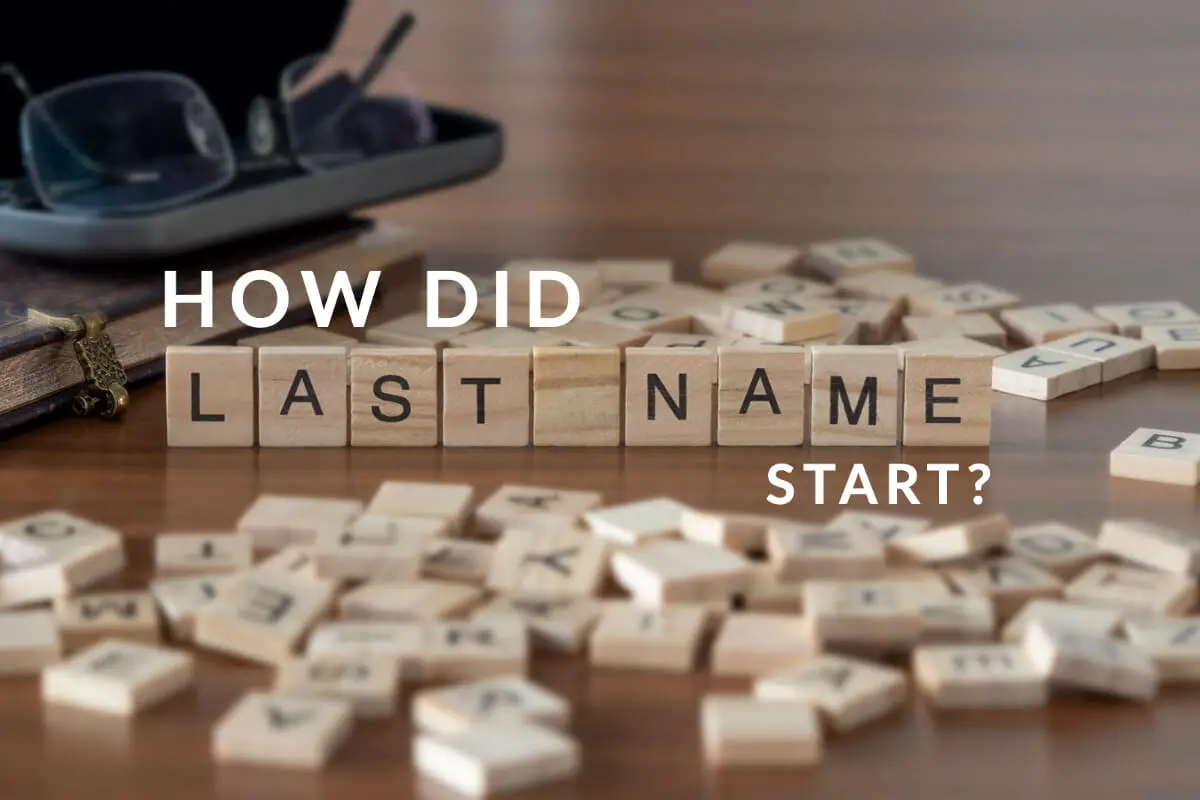Today we take it for granted that everyone has a last name or a surname. But this was not always the case in many countries and cultures.
Last names or surnames were added to a person’s first name to distinguish them from those with the same first name and who lived in the same area. Some countries adopted having a hereditary or passing down the last name from generation to generation early on. Other countries adopted the last name or surname much later; today, almost all nations and cultures have a previous or surname system.
Table of Contents
- How Using Last Names Or Surnames Started
- Last Names And Family History Research
- Frequently Asked Questions
- Related Content
When doing genealogy research, you must understand a little about the country you are researching and when last names were adopted as part of their country.
How Using Last Names Or Surnames Started
In many cultures, for a long time, people did not have a specific surname or what we know today as a family name or last name. Today, most people take it for granted that everyone has a family name, last name, or surname.
The surnames or last names were added to a person’s first name to help distinguish them from others with the same first name locally. In a place like England, they began to pass down hereditary surnames from generation to generation a thousand years ago.

The need for last names or surnames started as a way to identify people who lived in the same area. For example, if everyone were named John, it would be hard to locate which John you were looking for. That is why they often might have called someone John, the Baker, John, the Bookmaker, or John, the Butcher. This was a way that they distinguished which John it was.
But the problem arose: if you suddenly had two bakers named John, then which John the baker would you be talking about? That is why the last name is essential to help distinguish individuals and their families.
Depending upon the country you are doing your geological research or family history and when the adoption of surnames took place, you may or may not find a surname being used; this differs significantly from country to country and site to location.
Below are some examples to show two countries and when they adopted the surname or last name practice:
England – 1066 Norman Barons
In 1066 the Norman Barons introduced surnames into England. Even though not everyone adopted the surnames, they did begin to spread within a short period. Most people had adopted a surname that would be passed down.
That is why, if you are looking to do English genealogy, you will find that your ancestors will all have hereditary last names or last names passed down from one generation to the next.
This can make genealogy easier if you know your family’s last name, location, and a bit about your family; you can usually find the needed records.
Sweden Name’s Adoption Act 1901
Sweden adopted last names much later than the English. For example, in Sweden, if your father’s name was Jon and you were his daughter for a long time, your last name would be Jonsdotter. If you were Jon’s son, then you would be Jonson.
So even in the same family, a brother and sister would have two different last names, but they would both have the father’s first name to show that they were the son or daughter of Jon. For a long time, this worked very well in Scandinavia.
Sweden changed this with The Adoption Act in December 1901; this law required that all citizens adopt hereditary surnames, or in other words, surnames that would be passed down from parent to child, instead of changing every single generation.
At this time, many families adopted the surnames they had. For example, if the father was named Lars, they would have adopted the last name Larson or the son of Lars.
You can see in these two examples that England adopted last names 1000 years ago, while Sweden adopted them just over 100 years ago.
Last Names And Family History Research
Knowing the last name does not ensure that genealogy research will be easy. In many parts of the world, many people can have the same last name, and the same surname does not mean you are related to them.
Let’s go back to the example of Scandinavia. When doing your Swedish or Scandinavian research, you must understand exactly which part of Sweden or Scandinavia your ancestors came from.
If you are working on your Scottish, English, German, or other types of genealogy, you also need to understand the area they are from. When working on the Scottish genealogy, my ancestor’s name is James Johnston. I find many records with the name James Johnston.
The only way I can verify whether I have the right James Johnston is if I know a little bit about the Johnston family. For example, who was his father or mother, and what parish or place did they live in? Do you have any names of the siblings or other relatives?
All of these things can help you to be able to understand whether or not you have the correct James Johnston. When you go back to search genealogy records, there could be hundreds and thousands of James Johnstons all over Scotland and even England, so you must have some background information on your family.
Even if you have your ancestor’s surname, to fully understand if you are working on the correct family line, you must also understand something about your family.
That is why we say that Genealogy or family history research is a bit like being a detective; you must put together the pieces bit by bit, and one by one, to discover more about your ancestors, including who they are, where they lived, make sure that they are your relatives that you are related to.
If your ancestors come from a country or place where they adopted last names earlier on, then this is a bit easier than if you are researching a place where they did not. But whether they did or did not adopt the last name, you still need to have the same knowledge and understanding about where your ancestors lived and died.
The Hummel Family is a website all about Family History research. We focus on Swedish, German, English, Scottish, and American Genealogy. We also discussed Asia and China, as we had ancestors who spent many years in China.
You are welcome to join us and become part of our community by signing up for our FREE newsletter, The Hummel Family; sign up by clicking here.
Check out our YouTube channel, Family HIstory Buzz, by clicking here.
Frequently Asked Questions
hy did people start using last names?
Last names were introduced to distinguish individuals with the same first name, especially in communities where people lived in close proximity. It helped avoid confusion and identify specific individuals.
When did the practice of using last names begin?
The adoption of last names varied across cultures and regions. Some cultures implemented last names early on, while others introduced them later. The practice became more widespread over time.
What were the reasons for adopting last names?
Apart from avoiding confusion, last names often indicated a person’s occupation, place of origin, physical characteristics, or ancestry. They served as identifiers, providing additional information about an individual.
Were last names always hereditary?
The hereditary nature of last names differed among cultures. Some societies embraced the idea of passing down surnames from generation to generation, while others had more fluid naming systems.
How did occupations influence last names?
In many cases, last names reflected a person’s occupation. For instance, someone engaged in blacksmithing might be known as “Smith.” This practice of using occupational surnames was prevalent in various societies.
Did all cultures adopt last names at the same time?
No, the adoption of last names was not simultaneous across cultures. Different regions and societies implemented the use of last names at different points in history, and the reasons for doing so varied.
Were last names initially used by everyone?
Initially, last names were often associated with social status or specific roles in the community. Not everyone had a last name, and the use of surnames became more widespread as societies evolved.
How did the meaning behind last names change over time?
The meaning behind last names evolved, with some originally indicating a person’s physical features or occupation. Over time, these meanings might have shifted, and last names could become more symbolic or detached from their original significance.
What role did migration play in the adoption of last names?
Migration and movement of people often influenced the adoption of last names. Individuals who moved to new areas might have acquired or been assigned new surnames to integrate into the local naming conventions.
Are there cultures without a tradition of using last names?
While many cultures have embraced the use of last names, some indigenous or isolated communities may not follow this practice. These cultures might have alternative ways of distinguishing individuals within their communities.
Related Content
What Does Swabia Mean?
Swabia is a region in southern Germany; the people in this region speak Swabian German. Though the area is today part of modern-day Germany, historically and culturally, it was different. The name Swabia came from the Duchy of Swabia.
You can learn more by reading What Does Swabia Mean? About Swabian German by clicking here.
What Is The History of Westphalia, Germany?
Westphalia’s history goes back to the times of the ancient Saxons. For some time, Westphalia was under the rule of Napoleon and the French. Later Westphalia became a state of Prussia until it officially became part of Germany in 1945.
You can learn more by reading A History of Westphalia, Germany by clicking here.
